What Are the Best Drapery Fabrics for Sunrooms?
TLDR;
The best
drapery fabrics for sunrooms are UV-resistant materials like solution-dyed acrylics, polyester blends, and performance fabrics because they resist fading and heat damage. Natural fabrics like cotton and linen also work well when treated or layered for durability. Your choice depends on whether you want more light diffusion, privacy, or insulation.
Why Choosing the Right Drapery Fabric Matters in a Sunroom
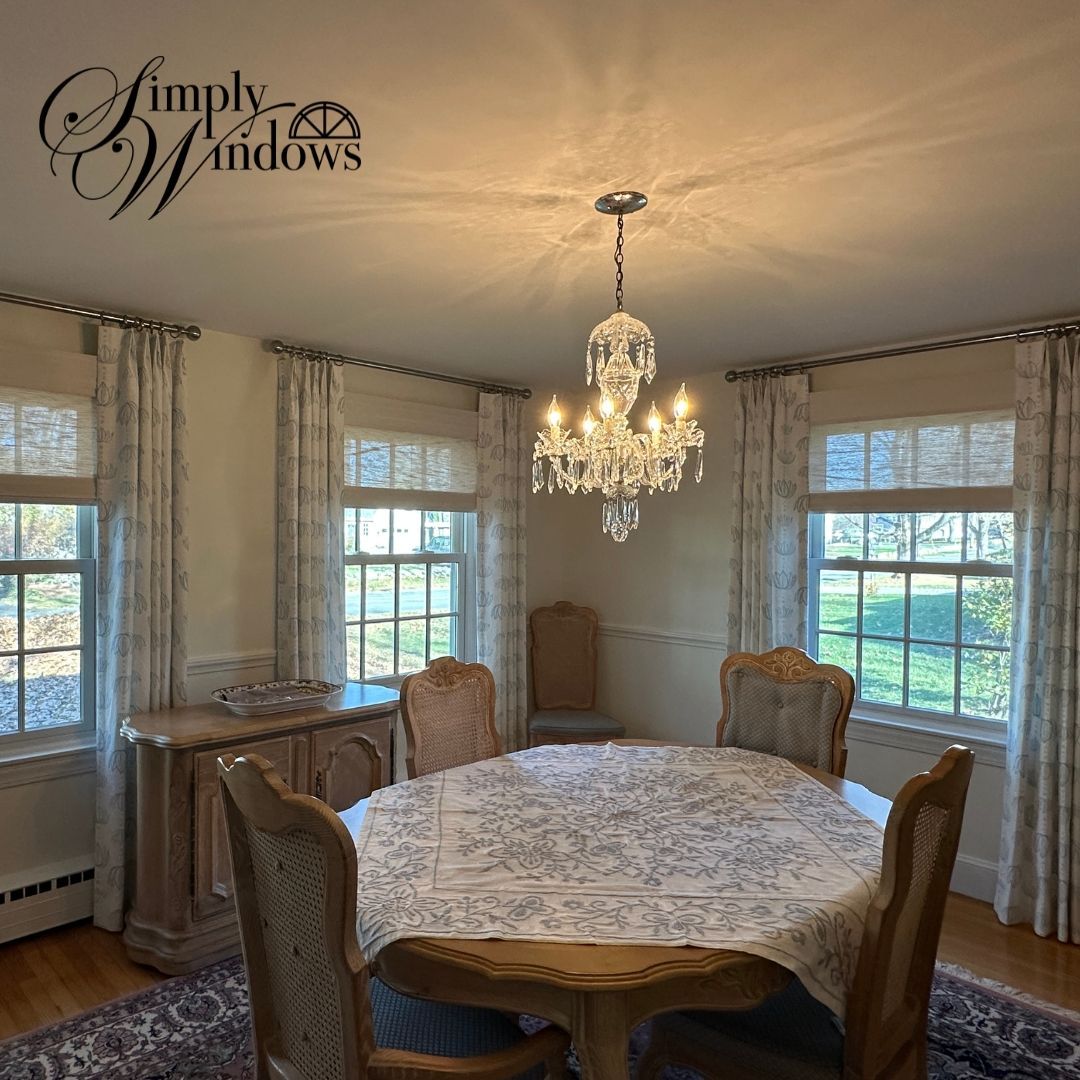
Sunrooms are exposed to high levels of sunlight, heat, and fluctuating temperatures. Standard drapery fabrics tend to fade, weaken, or lose shape when used in these conditions. Choosing the right material ensures your investment lasts longer while also controlling light and maintaining comfort.
The Challenge of Sun Exposure, Heat, and UV Rays
Sunrooms are filled with direct sunlight for hours each day. UV rays weaken fibers and cause colors to fade. Heat build-up can also damage untreated materials. Fabrics must resist UV penetration and hold structure even under intense exposure.
Fading, Fabric Degradation, and Longevity
Cheap or untreated materials fade quickly in a sunroom. Cotton, linen, and other naturals often require treatments to improve performance. Synthetic fabrics like polyester and acrylic resist color loss longer, making them better for heavy exposure.
Light Control, Privacy, and Insulation Trade-Offs
- Sheer fabrics filter natural light but offer little privacy
- Heavier materials add privacy and insulation but reduce brightness
- Thermal-backed or blackout-lined fabrics block heat and give full privacy
The right balance depends on how you use your sunroom.
Top Drapery Fabric Options for Sunrooms (Pros & Cons)
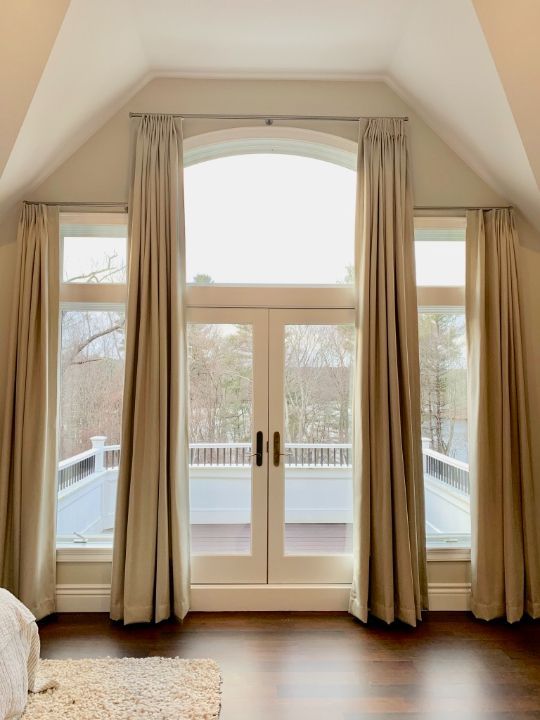
When choosing the right drapery materials for sun-filled spaces, it’s important to compare how different indoor drapery fabrics perform in terms of UV resistance, light control, and durability. Below are some of the best options and their pros and cons.
Cotton and Cotton Blends
- Pros: Affordable, breathable, versatile, easy to find
- Cons: Fades faster if untreated, can shrink after washing
- Best use: Layered with liners or used in low-sun areas of the room
Linen and Linen Blends
- Pros: Airy texture, breathable, creates a light-diffused glow
- Cons: Wrinkles easily, prone to fading without protective treatment
- Best use: Casual or coastal-style sunrooms where light diffusion is key
Polyester and Microfiber Blends
- Pros: Durable, fade-resistant, easy to maintain, cost-effective
- Cons: Can look less natural than linen or cotton, may trap heat if too heavy
- Best use: Everyday drapery where strength and longevity matter
Performance Fabrics and Solution-Dyed Acrylics
- Pros: Highest UV resistance, strong fade protection, moisture-resistant
- Cons: More expensive than standard polyester or cotton
- Best use: West- or south-facing sunrooms with heavy exposure
Sheer Fabrics (Voile, Organza, Mesh)
- Pros: Allow light to filter in, soften glare, lightweight look
- Cons: Provide little privacy or insulation, degrade faster in high sun
- Best use: Layered with heavier drapes or blinds for versatility
Specialty and Hybrid Fabrics
- Blackout-lined fabrics: Block heat, glare, and UV completely
- Thermal-backed drapes: Improve insulation and energy efficiency
- Treated fabrics: Enhanced with UV inhibitors, fade-resistant coatings
- Best use: Homes where controlling temperature and privacy is the top priority
Comparative Feature Analysis: Which Fabric Does What
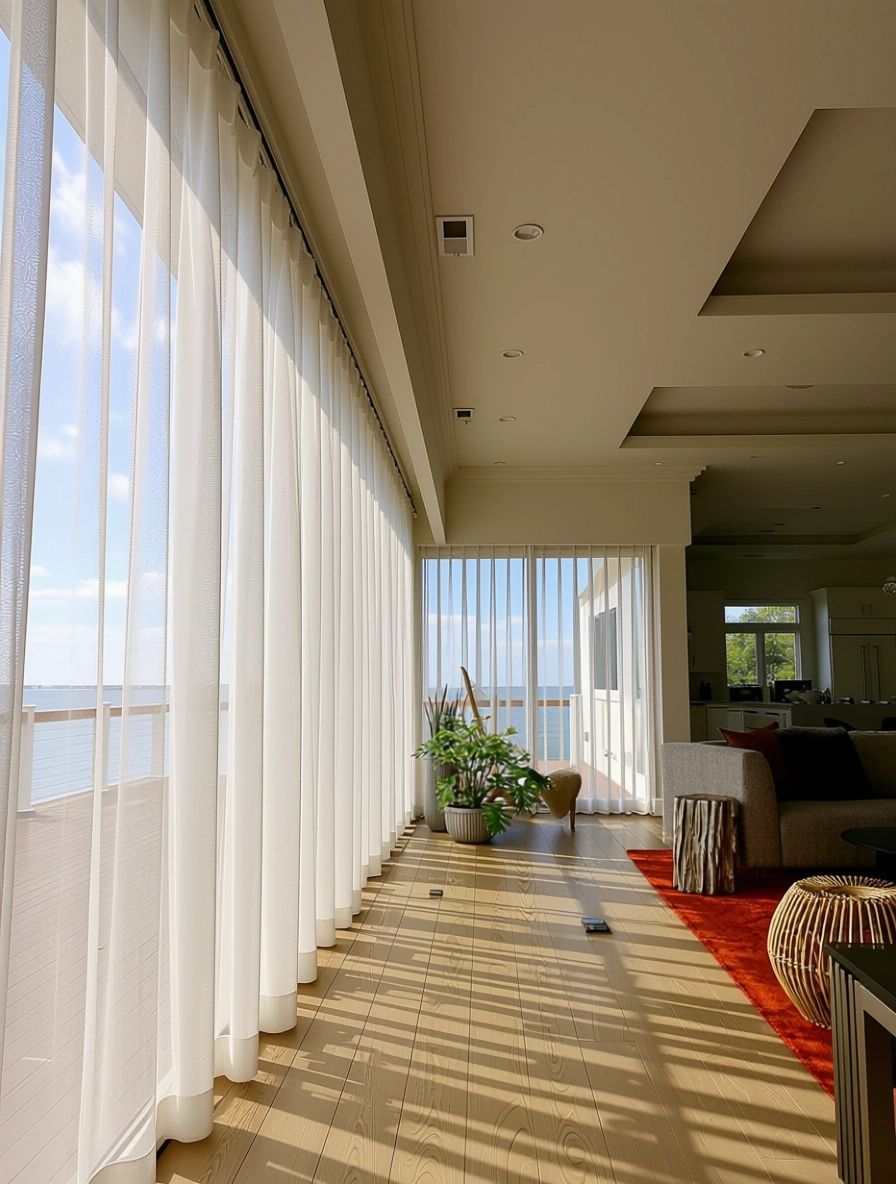
Light Filtering vs Full Blackout
- Sheer or linen: Good for soft light and ambiance
- Blackout or thermal fabrics: Best for maximum privacy and energy efficiency
Durability, Abrasion, and Fade Resistance
- Performance fabrics and solution-dyed acrylics: Highest resistance
- Cotton and untreated linen: Lowest resistance without added protection
Insulation and Energy Efficiency
- Thermal-backed polyester: Retains heat in winter, blocks heat in summer
- Linen and cotton: More breathable but less insulating
Maintenance, Cleaning, and Care
- Polyester: Machine-washable, low maintenance
- Linen and cotton: Require gentle washing or dry cleaning
- Acrylics: Easy to clean with mild soap and water
Safety and Fire-Retardant Fabrics
For sunrooms with fireplaces or high heat exposure, fire-retardant fabrics are recommended. Look for NFPA-rated drapery materials if safety is a concern.
Design and Aesthetic Considerations for Sunroom Draperies
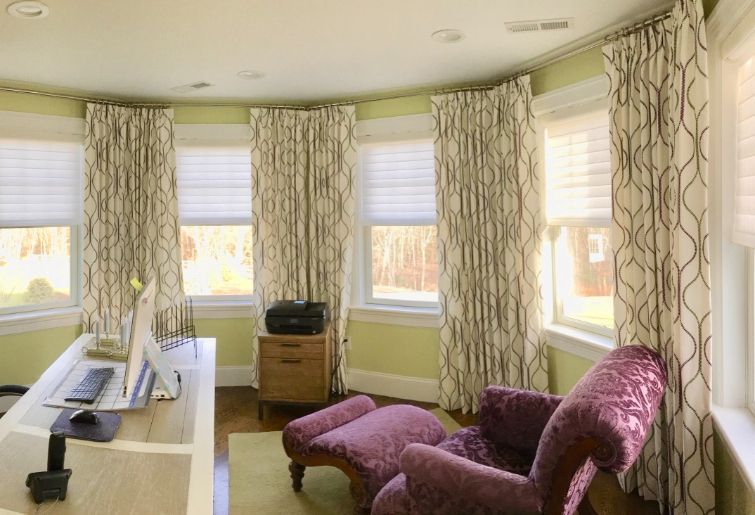
Color, Pattern, and Texture
- Light colors reflect heat and reduce fading
- Bold patterns disguise wear over time
- Textured fabrics add depth to a bright room
Layering Strategies
- Sheer plus blackout: Light during the day, privacy at night
- Drapes with blinds: Flexibility in light control and insulation
Hardware, Rods, Linings, and Header Styles
- Grommets: Modern look, easy glide
- Pleats: Classic and structured
- Rod pocket: Traditional, less functional in high-use areas
Hanging Height, Fullness, and Visual Proportions
- Higher placement makes the room look taller
- Fullness ratio of 2x to 2.5x fabric width improves luxury feel
Matching Drapery Style to Sunroom Architecture
- Minimalist designs fit modern glass sunrooms
- Heavy-lined drapes complement traditional builds
Practical Tips for Choosing and Installing Drapery Fabrics in Sunrooms
Measuring Your Windows
- Measure width and length twice for accuracy
- Add extra inches for fullness and light-blocking
Determining Appropriate Fullness and Fabric Yardage
- Plan for at least double the window width in fabric
- Consider pleats or folds when calculating yardage
Sample Swatching in Sunlight
- Hang small swatches in the sunroom for a week
- Check for fading or color shifts before committing
Installation and Mounting Best Practices
- Use sturdy rods for heavier fabrics
- Install brackets securely to handle fabric weight
Seasonal Care and Rotation
- Rotate drapes seasonally to reduce uneven fading
- Clean regularly to avoid dust and fabric weakening
FAQs
What fabric is best for a sunroom with extreme sunlight?
Solution-dyed acrylics or performance polyester fabrics are the best for resisting fading and UV damage.
Are sheer curtains effective in a sunroom?
Yes, for light diffusion, but they need to be layered for privacy and insulation.
Can blackout curtains work well in a sunroom?
Yes, they block heat and UV rays, making the space more energy-efficient.
How do I clean sunroom drapery fabrics?
Most polyester and acrylic fabrics are easy to clean with mild detergent. Linen and cotton often require gentle washing or dry cleaning.
Do I need UV protections or liners for sunroom drapes?
Yes, liners extend fabric life and reduce fading, especially for cotton and linen.
Final Thoughts and Fabric Recommendation Guide
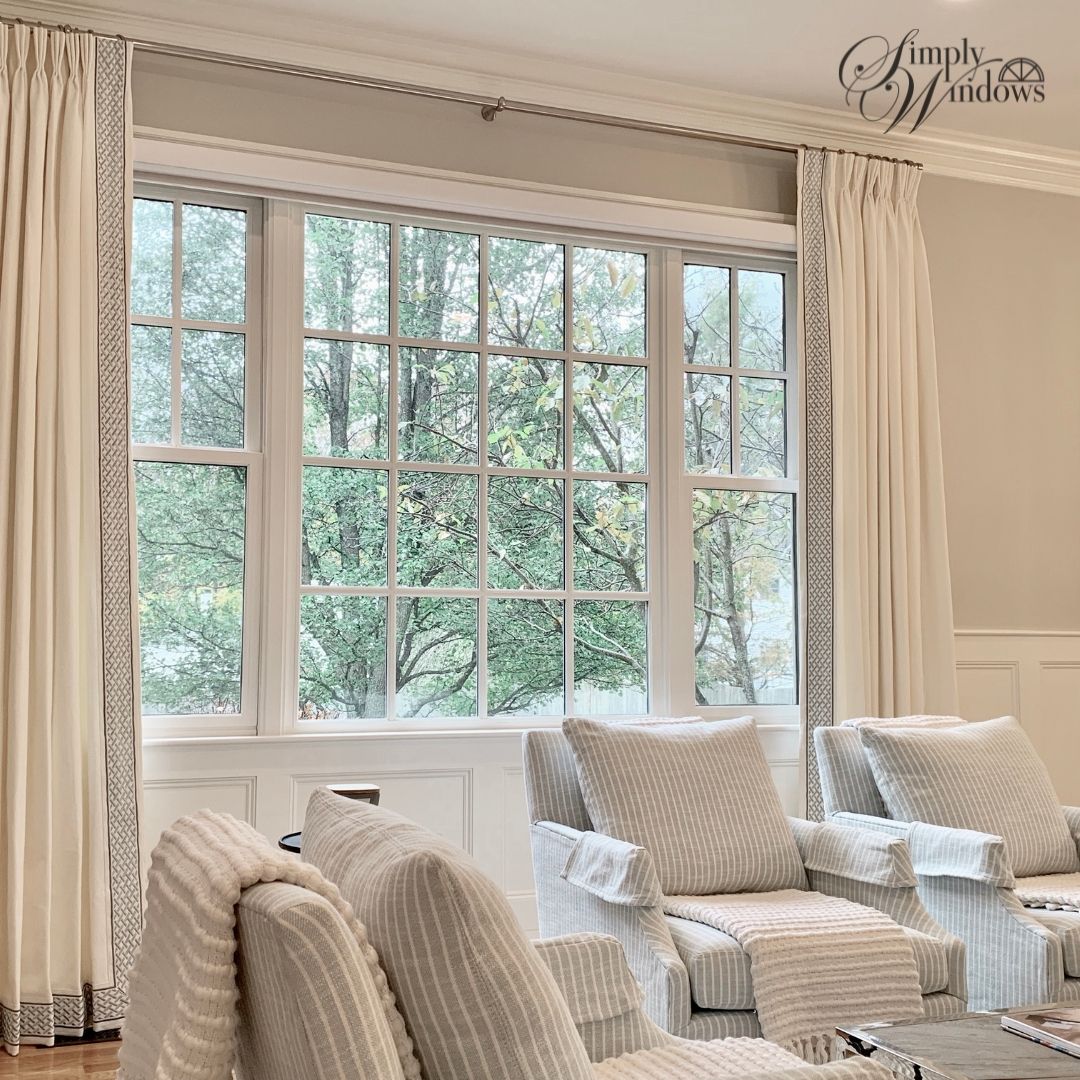
Quick Decision Matrix
- Best all-around: Performance polyester
- Best for heavy sun: Solution-dyed acrylic
- Best for style: Linen blends with protective lining
- Best budget option: Cotton with UV-protective liner
Summary of Trade-Offs
- Natural fabrics are breathable and stylish but need protection
- Synthetic fabrics last longer and resist fading but feel less organic
- Layering combines the benefits of both
Simply Windows recommends investing in fabrics that balance durability, UV resistance, and design. For sunrooms with heavy exposure, solution-dyed acrylics or performance polyester are the strongest choices. For style-focused rooms with moderate sun, linen or cotton blends with liners work best. The right drapery fabric ensures your sunroom remains comfortable, stylish, and functional for years.

